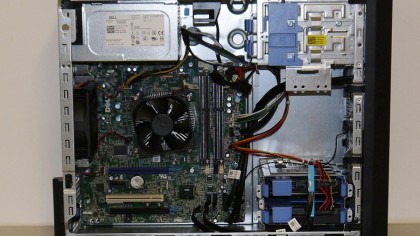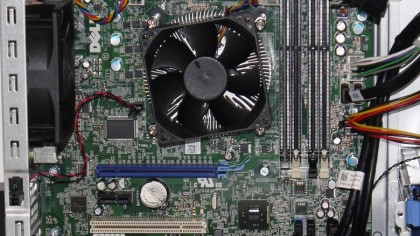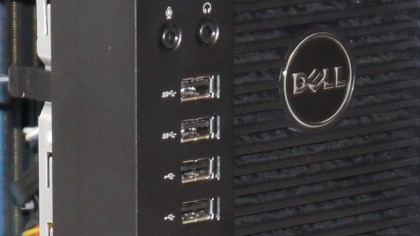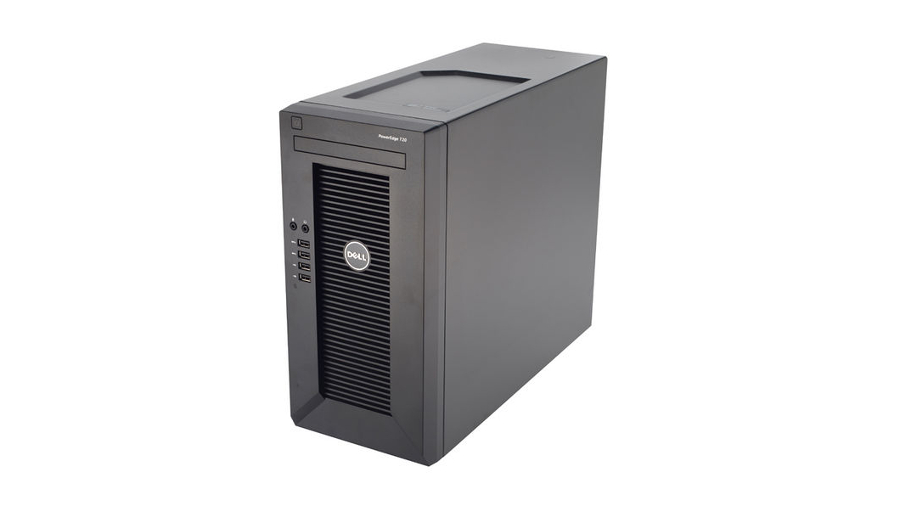TechRadar Verdict
A lot of server for the price of the average desktop, the PowerEdge T20 is fast and has room for lots of storage. The base configuration is a bit lean, but it's still a capable entry-level system and good value for money.
Pros
- +
Compact mini-tower with easy access to internals
- +
Fast quad-core Xeon processor
- +
Room for six internal disks
- +
On-board RAID
- +
Lots of USB ports
Cons
- -
Single Gigabit network port
- -
No embedded hypervisor option
- -
No hot-swapping of disks
- -
Needs more than 4GB of RAM
- -
Basic Intel AMT management
Why you can trust TechRadar
The new baby of the Dell server family, the PowerEdge T20, is designed for small businesses looking for a platform for shared storage and to host applications such as email, web and database servers. Alternatively it could be used as a departmental or branch server where it faces stiff competition from arch-rival HP with its ProLiant MicroServer Gen 8.
Small choices
The days when you could more or less specify your own Dell server from an extensive list of options are long gone, especially when it comes to entry-level systems like the PowerEdge T20. Some buyers may be disappointed by this but it does make life easier with just the one freestanding mini-tower chassis available for the T20 fitted with a single 290W power supply.
Neither as well-built or compact as the MicroServer Gen8, the Dell chassis is of workmanlike construction with a removable side panel giving plenty of access to the internals, including a compact mini-ATX motherboard mounted towards the bottom of the tower. Up to six SATA hard disks can be accommodated inside the casing with metalwork provided to accommodate two 3.5-inch disks at the bottom and two more in the top of the tower.

Unfortunately the disks can't be hot-swapped and the two at the top are only accessible by removing the front panel. Moreover, although a further two 2.5-inch drives can be fitted in the space otherwise used to take an optical drive, the on-board controller only has four SATA ports which means fitting an additional adapter if you want to use all the available bays.
When it comes to the disks themselves you can either source your own or have them pre-fitted by Dell, with a choice of magnetic disks up to 3TB currently available for online ordering plus a 160GB SSD. The integrated RAID controller offers support for disk mirroring and striping, but if you want RAID 5 you (again) have to plug in an extra controller.
The only other major option is the CPU and even here you're limited to a choice of just two with buyers on a budget likely to go for the 3GHz Pentium G3220 which, when accompanied by a standard 4GB of memory and no hard disks, keeps the base price down to just £219 ex. VAT (around US$375, AUD$400). That, however, could be a false economy as the dual-core G3220 is more of a desktop than server processor, and most buyers will be better off with the more capable Xeon processor, in this case a quad-core 3.2GHz Xeon E3-1225 v3.
With an 84W TDP and accompanied by 4GB of memory plus a 1TB SATA hard disk this configuration is much better suited to the server role yet still comes in at just £389 ex. VAT (around US$670, AUD$715), rising to £445 (around US$765, AUD$815) if you add a second 1TB drive to support disk mirroring.
Growth potential
Given that the T20 is a server the standard 4GB of ECC protected memory seems a little stingy, especially as it doesn't cost a lot to upgrade. Fortunately the base 4GB comes on just one DIMM leaving three slots free to take more. Doubling up to 8GB can be done for a shade under £50 ex. VAT (around US$85, AUD$90), and is highly recommended, with up to 32GB possible altogether should you wish for more.

With just one Gigabit network interface some customers may also want to add an extra LAN adapter as well as a more capable RAID controller, with three full-length PCI Express slots available for just this purpose (plus an old style PCI slot).
You'll also find USB ports all over the place – four at the front and six at the back. Moreover two of each set are USB 3.0, plus there are controls in the BIOS to turn off those you don't need, presumably to stop rogue devices being attached.

One final consideration is the need to factor in the cost of an operating system as this isn't included in the basic price. Linux is supported if required, but those wanting to run Windows Server Essentials 2012 R2 will find it adding around £225 ex VAT (around US$385, AUD$410) to the overall cost. Alternatively it would be possible to boot straight to a hypervisor from disk or SSD, but there's no USB or SD slot to take an embedded hypervisor as on the HP MicroServer.
